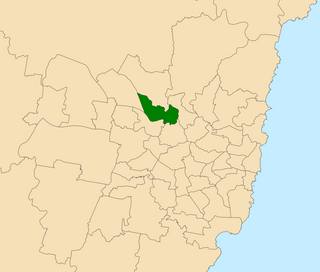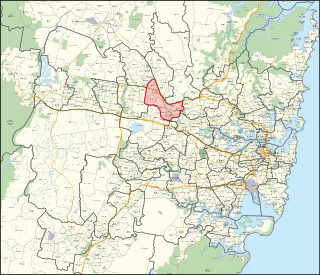
Baulkham Hills was an electoral district of the Legislative Assembly in the Australian state of New South Wales. Its last member was David Elliott of the Liberal Party.
Wentworthville was an electoral district of the Legislative Assembly in the Australian state of New South Wales, first created in 1962. The seat was absorbed into surrounding electorates in a redistribution prior to the 1991 election and recreated in the redistribution prior to the 1999 election. At the 2003 election, Pam Allan won the seat with 54% of the first preference votes. This was a marginal improvement over the 1999 election. It was abolished again for the 2007 election, with the larger part of it going to the new electoral district of Toongabbie.
Port Jackson was an electoral district of the Legislative Assembly in the Australian state of New South Wales. It was created at the 1991 election, largely from the electorates of Balmain and McKell, and was abolished at the 2007 election being substantially replaced by the recreated electorates of Balmain and Sydney following a redistribution of electoral boundaries completed during 2004.
West Maitland was an electoral district for the Legislative Assembly in the Australian State of New South Wales from 1859 to 1904, including the town of Maitland. It was abolished in 1904 due to the re-distribution of electorates following the 1903 New South Wales referendum, which required the number of members of the Legislative Assembly to be reduced from 125 to 90. It was largely replaced by the new district of Maitland and the balance absorbed by Northumberland.
Singleton was an electoral district of the Legislative Assembly in the Australian colony of New South Wales created in 1894, existing from 1894 until 1913. It was named after the town of Singleton and replaced Patrick's Plains.
Robertson was an electoral district of the Legislative Assembly in the Australian state of New South Wales from 1894 to 1904, in the upper Hunter Region around Scone and named after John Robertson. The district was created when multi-member constituencies were abolished in 1894, and comprised the eastern part of the Upper Hunter and the western part of Patrick's Plains. The district was abolished in 1904 as a result of the 1903 New South Wales referendum, which reduced the number of members of the Legislative Assembly from 125 to 90, and largely replaced by a re-created Upper Hunter.
Uralla-Walcha was an electoral district of the Legislative Assembly in the Australian state of New South Wales, including the towns of Uralla and Walcha. It was originally created in 1894, when multi-member districts were abolished, and the three member district of New England was largely divided between Uralla-Walcha, Armidale and Bingara. The district was abolished in 1904 as a result of the 1903 New South Wales referendum, which reduced the number of members of the Legislative Assembly from 125 to 90, and was divided between Armidale and Bingara.
The Gwydir was an electoral district of the Legislative Assembly in the Australian state of New South Wales, created in 1859, when Liverpool Plains and Gwydir was divided, and named after and including the Gwydir River. In 1894 it was abolished and largely replaced by Moree and Barwon. It was re-created in the 1904 re-distribution of electorates following the 1903 New South Wales referendum, which required the number of members of the Legislative Assembly to be reduced from 125 to 90. It consisted of the abolished seat of Moree and part of Inverell. It was abolished in 1920, with the introduction of proportional representation and largely merged, along with Tamworth, into Namoi.
Wellington was an electoral district of the Legislative Assembly in the Australian state of New South Wales, created in 1859 and named after and including Wellington. It replaced part of Wellington (County). It was abolished in 1904 due to the re-distribution of electorates following the 1903 New South Wales referendum, which required the number of members of the Legislative Assembly to be reduced from 125 to 90. The district was largely replaced by an expanded The Macquarie, while parts also went to Liverpool Plains and Mudgee.

Seven Hills was an electoral district of the Legislative Assembly in the Australian state of New South Wales. It is represented by Mark Taylor of the Liberal Party.
Sydney-Pyrmont was an electoral district of the Legislative Assembly in the Australian state of New South Wales, created in 1894, partly replacing the multi-member electorate of West Sydney. It was named after and included the Sydney suburb of Pyrmont, consisting of the entire peninsula north of Fig Street and east of Wattle Street. In 1904, it was largely replaced by Pyrmont, which also absorbed part of the abolished district of Sydney-Denison.
King was an electoral district in the Australian state of New South Wales. It was created in 1904 as a result of the 1903 New South Wales referendum, which required the number of members of the Legislative Assembly to be reduced from 125 to 90. It largely replaced Sydney-King, losing a part to Darling Harbour. It was expanded to include parts of Sydney-Fitzroy and Sydney-Bligh. It also included Lord Howe Island, Montague Island and South Solitary Island.
St George was an electoral district of the Legislative Assembly in the Australian state of New South Wales, named after the St George district. It was originally created in 1894, when multi-member districts were abolished, and the four member Canterbury was largely divided between Ashfield, Burwood, Canterbury, Petersham and St George. In 1920, with the introduction of proportional representation, St George was expanded to a five-member district, absorbing the electoral districts of Canterbury and Hurstville. Proportional representation was abolished in 1927, and St George was divided into the single member electorates of St George, Canterbury, Hurstville, Oatley and Rockdale. St George was abolished in 1930, being partly replaced by Arncliffe.
Concord was an electoral district of the Legislative Assembly of the Australian state of New South Wales, created in 1930, and named after and including the Sydney suburb of Concord. It was abolished in 1968.
Ballina, an electoral district of the Legislative Assembly in the Australian state of New South Wales, was established in 1894. In 1904 it was abolished and replaced by Byron. It was re-established in 1988, largely replacing Lismore.
Toongabbie, an electoral district of the Legislative Assembly in the Australian state of New South Wales was created in 2007 and abolished in 2015.
Holsworthy, an electoral district of the Legislative Assembly in the Australian state of New South Wales, was created in 2015, largely replacing Menai.
Summer Hill, an electoral district of the Legislative Assembly in the Australian state of New South Wales, was first established in 2015, partly replacing Marrickville.
Prospect, an electoral district of the Legislative Assembly in the Australian state of New South Wales, was created in 2015, largely replacing Smithfield.

Winston Hills is an electoral district of the Legislative Assembly in the Australian state of New South Wales. It is represented by Mark Taylor of the Liberal Party.




